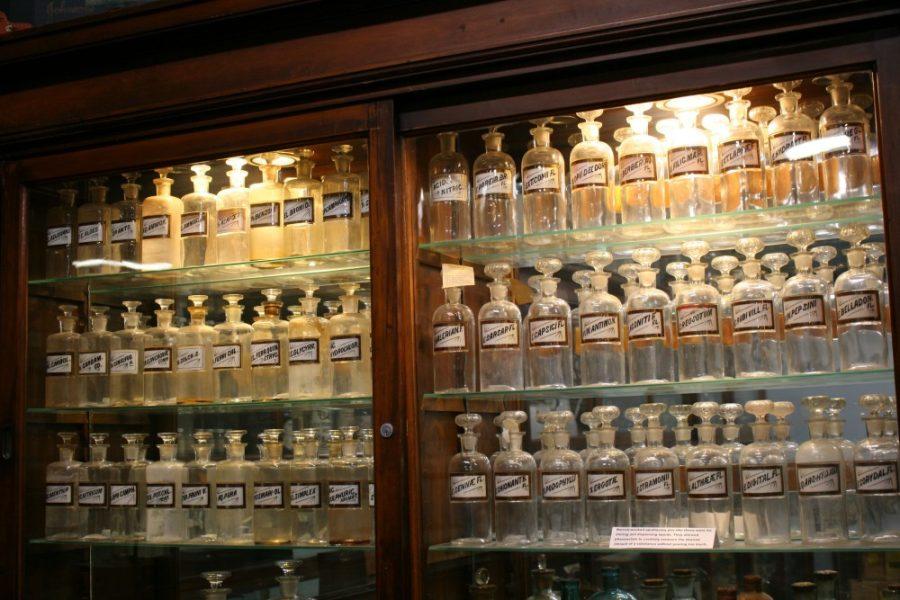UA’s Pharmacy Museum at the UA College of Pharmacy officially opened in 1966 and still, after recently celebrating its 50th year of running, continues to receive recognition as a prized museum for pharmacy artifacts and history.
The museum is home to all kinds of medicinal items that date back as far as the 1850s. From unique items like asthma cigarettes and medicinal wine, the Pharmacy Museum has one of the largest collections of pharmaceutical artifacts.
The museum emerged after a former Tucson pharmacist, Jesse Hurlbut, donated his collections of antique pharmacy items from over the years.
Stephen Hall, an assistant curator at the Pharmacy Museum with a masters degree in library and informational sciences from the UA, often gives tours and provides information about the history of the museum.
RELATED: UA College of Pharmacy receives $1.25 million for scholarships
Hall said the museum’s layout is scattered throughout the Pharmacy building.
“It’s hard to know the exact amount of people who come to visit every day since it’s always open to the public, but we do know that we have students visiting and viewing the museum every day,” Hall said.

When asked about some of the most interesting artifacts the museum has to offer, Hall had a handful of pharmaceutical items that fit the criteria.
The museum has a large collection of “show globes” that are large, hanging, colored, glass fixtures that were the physical symbol of a pharmacy location. Hall said show globes are thought to date back to the 1500s and let people know where a doctor was in Europe.
“No one knew how to read, so it was a visual indicator of where the doctor was,” he said.
Among the show globes are medicines like asthma cigarettes that contained no tobacco but were instead filled with medicinal leafs called belladonna and stramonium.
The museum’s collection included tools used to make the medicine. Before the 1900s nearly every type of medicine was made from scratch with the assistance of tools like a mortar and pestle, which help grind ingredients.
“Mortars and pestles have been around for the majority of human existence,” Hall said. “There’s even reference of the invention in the Old Testament of the Bible.”
In addition to the mortars and pestles, the museum also showcased apothecary jars that stored various materials and medicines. These jars are fairly large, beautifully detailed and are scattered all around the museum. Placed with the jars are various tinted medicinal bottles and glass bottles with cork stoppers.
“We have tons of medicinal bottles in our drawers, and we have clear, glass bottles that are almost as old as the Arizona state itself,” Hall said.
The Pharmacy Museum is also home to a variety of aged cosmetic products like perfumes, soaps and shampoos. The bottles of most of the products were aged and remained untouched. Hall said many of the bottles have contents and the museum keeps these contents inside the bottles to preserve their authenticity.
RELATED: When you work in a museum, you got to dance
One of the most recognized parts of the museum’s exhibit is their collection of pharmacy items from Disneyland that date back to when the amusement park originally opened in 1955. At the time, the well-known Upjohn pharmaceutical company was invited to open a store in Disneyland until it was closed in 1970 and was replaced by the New Century Clock and Watch Shop.

“Now, the space is used as a gift shop at Disneyland, and we have kept almost 900 items from the Upjohn Company,” Hall said. “California Science Center had the items after it closed, and then in the early 2000s it was given to the UA.”
Hall emphasized the rarity of the pharmacy museum.
“In general, there is very little literature in pharmacy or any documentation of it, so this museum really preserves the history of the profession,” Hall said.
Hall said that no matter what field a person decides to study, one can always learn from the profession’s history.
“By looking back in the past, we can learn and figure out where we are going to go in the future,” Hall said.
The pharmacy museum is open Monday through Friday from 8 a.m. to 5 p.m. There is free admission, and tours are available for free as well.
Follow Savanah Modesitt on Twitter.









